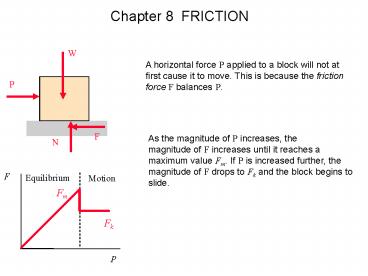chapter 8 review - PowerPoint PPT Presentation
1 / 10
Title:
chapter 8 review
Description:
... screws (frequently used in jacks, presses and other mechanisms) is. reduced to the analysis of a block sliding on an incline by unwrapping the thread of the screw ... – PowerPoint PPT presentation
Number of Views:23
Avg rating:3.0/5.0
Title: chapter 8 review
1
Chapter 8 FRICTION
W
A horizontal force P applied to a block will not
at first cause it to move. This is because the
friction force F balances P.
P
F
As the magnitude of P increases, the magnitude
of F increases until it reaches a maximum value
Fm. If P is increased further, the magnitude of F
drops to Fk and the block begins to slide.
N
F
Equilibrium
Motion
Fm
Fk
P
2
W
Equilibrium
Motion
F
Fm
P
Fk
F
P
N
The forces Fm and Fk are proportional to the
normal component N of the reaction of the
surface. We have
Fm ms N Fk mk N
where ms is the coefficient of static friction
and mk is the coefficient of kinetic friction.
These coefficients depend on the nature and the
condition of the surfaces in contact.
3
W
It is sometimes convenient to replace the normal
force N and the friction force F by their
resultant R. As the friction force increases and
reaches its maximum value Fm msN, the angle f
that R forms with the normal to the surface
increases and reaches a maximum value fs, called
the angle of static friction.
P
R
N
f
F
F R sin f N R cos f
4
W
If motion actually takes place, the magnitude of
F drops to Fk similarly the angle f drops to a
lower value fk , called the angle of kinetic
friction. The coefficient of friction and the
angle of friction are related by
P
R
N
f
F
F R sin f N R cos f
tan fs ms tan fk mk
5
W
P
Frequired
N
The magnitude F of the friction force is equal to
Fm msN only if the body is about to slide. If
motion is not impending, F and N should be
considered as independent unknowns to be
determined from the equilibrium equations. The
value of F required to maintain equilibrium
should be checked to insure that it does not
exceed Fm.
6
W
P
Fm msN
N
If motion is known to be impending, F has
reached its maximum value Fm msN , and this
expression may be substituted for F in the
equilibrium equations.
7
B
A
P
C
D
In the analysis of wedges, two or more free-body
diagrams are generally used to show each
friction force and its correct sense.
8
W
The analysis of square- threaded screws
(frequently used in jacks, presses and other
mechanisms) is reduced to the analysis of a
block sliding on an incline by unwrapping the
thread of the screw and showing it as a straight
line.
Q
L
R
q
fs
q
2pr
In doing this, r denotes the mean radius of the
thread, L is the lead of the screw (the distance
through which the screw advances in one turn), W
is the load, and Qr is the torque exerted on the
screw.
9
P
P
Dq
P2
q
P1
b
O
T2
T1
For a flat belt passing over a cylinder, it is
important to determine the direction in which the
belt slips or is about to slip. If the drum is
rotating, the motion or impending motion of the
belt should be determined relative to the
rotating drum.
10
P
P
If the belt shown is about to slip to the right
relative to the drum, the friction force will be
directed to the left and the tension will be
larger in the right-hand portion of the belt than
the left-hand portion.
Dq
P2
q
P1
b
O
T2
T1
Denoting T2 as the larger tension, ms as the
coefficient of static friction, and b as the
angle (in radians) subtended by the belt, the two
tensions are related by
T2 T1
T2 T1
msb
ln msb
e































